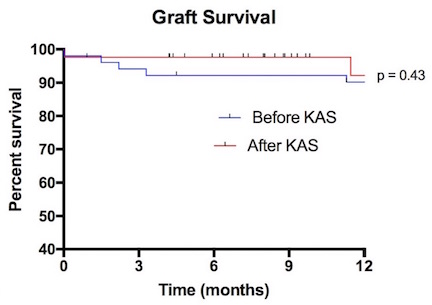The Impact of the Kidney Allocation System on Outcomes for Kidneys with KDPI > 85%.
1Division of Transplant Surgery, University of California, Davis, Sacramento, CA
2Division of Transplant Medicine, University of California, Davis, Sacramento, CA
Meeting: 2017 American Transplant Congress
Abstract number: A100
Keywords: Allocation, High-risk, Kidney transplantation, Resource utilization
Session Information
Session Name: Poster Session A: Deceased Donor Issues I: Allocation, KDPI and Recipient Selection
Session Type: Poster Session
Date: Saturday, April 29, 2017
Session Time: 5:30pm-7:30pm
 Presentation Time: 5:30pm-7:30pm
Presentation Time: 5:30pm-7:30pm
Location: Hall D1
Single center outcomes were examined to assess the impact of the implementation of the Kidney Allocation System (KAS) on outcomes for kidneys with KDPI >85%.
Methods: A retrospective analysis was performed for all kidney transplants performed at a single center using kidneys with KDPI > 85% between 3/2012 and 7/2016. Kidneys from donors < 20 kg were excluded. Recipient outcomes and donor characteristics for transplantations prior to KAS were compared to those after its implementation on Dec 4, 2014.
Results: Kaplan-Meier curves show no statistical difference in allograft survival. 6-month graft survival before and after KAS was 92.2% and 97.6%, respectively. Imports increased from 71% to 95% (p=.002). Cold ischemia time (CIT) was unchanged overall, but was lower in regional imports (Table 1). DCD donors increased from 13.7% to 38.1% (p=.007). Comparing a 20-month period before and after KAS, the rate of transplants of >85% KDPI kidneys increased (mean 1.3/month vs 2.5/month).
| Before KAS | After KAS | P value | |
| N | 51 | 42 | |
| Recipient Age (yrs) | 64.2 ± 0.9 | 65.1 ± 1.2 | P = 0.51 |
| KDPI | 92.2 ± 0.6 | 90.7 ±0.5 | p=0.06 |
| Imports | 71% | 95% | p = 0.022 |
| Regional Imports | 39% | 48% | p=0.53 |
| DCD % | 13.7% | 38.1% | p=0.007 |
| DGF | 27.5% | 38.1% | p=0.27 |
| 6-month eGFR | 45.7 ± 2.4 | 41.5 ± 2.8 | |
| CIT (hrs) | 29.1 ± 1.7 | 30.0 ± 1.2 | p = 0.68 |
| CIT for regional imports (hrs) | 31.7 ±1.6 | 26.3±1.6 | p = 0.022 |
| Transplants/month | 1.3 | 2.5 | p = 0.059 |
Conclusion: With implementation of KAS there was an increase in importation of high KDPI kidneys, and more efficient regional utilization suggested by improved CIT with regional imports. Graft survival was unchanged, and exceeded KDPI expected outcomes.
CITATION INFORMATION: Perry A, Sageshima J, Santhanakrishnan C, McVicar J, Troppmann C, De Mattos A, Woloszyn J, Perez R. The Impact of the Kidney Allocation System on Outcomes for Kidneys with KDPI > 85%. Am J Transplant. 2017;17 (suppl 3).
To cite this abstract in AMA style:
Perry A, Sageshima J, Santhanakrishnan C, McVicar J, Troppmann C, Mattos ADe, Woloszyn J, Perez R. The Impact of the Kidney Allocation System on Outcomes for Kidneys with KDPI > 85%. [abstract]. Am J Transplant. 2017; 17 (suppl 3). https://atcmeetingabstracts.com/abstract/the-impact-of-the-kidney-allocation-system-on-outcomes-for-kidneys-with-kdpi-85/. Accessed December 25, 2025.« Back to 2017 American Transplant Congress
